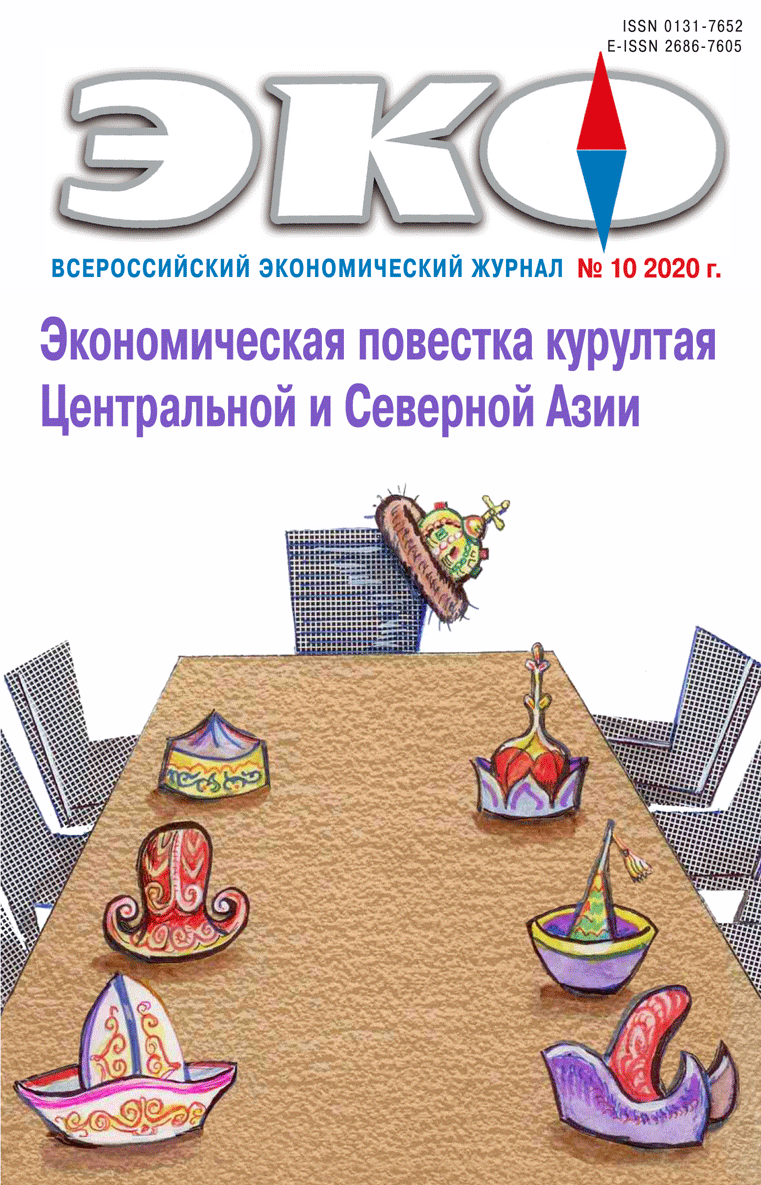Тема номера: ЭКОНОМИЧЕСКАЯ ПОВЕСТКА КУРУЛТАЯ ЦЕНТРАЛЬНОЙ И СЕВЕРНОЙ АЗИИ
Is Economic Integration Possible in the Central Asia? A Regional Vector of Kazakhstan’s Policy
Published 2020-10-02
Keywords
- regional studies,
- the Central Asian region,
- regional integration,
- regional conflicts,
- extraregional influence
- the ‘belt and road’ initiative,
- EAEИ ...More
How to Cite
1.
Duysen Г, Aytghanova Д, Teslya П. Is Economic Integration Possible in the Central Asia? A Regional Vector of Kazakhstan’s Policy. ECO [Internet]. 2020 Oct. 2 [cited 2025 Nov. 30];50(10):8-33. Available from: https://ecotrends.ru/index.php/eco/article/view/4125
Abstract
The paper examines problems of regionalism and conflicts of interests in Central Asian countries that create obstacles to intraregional integration, revealing a special role that Kazakhstan plays in the sub-region. The degree of integration of economies of Kazakhstan, Kyrgyzstan, Tajikistan, Turkmenistan and Uzbekistan is estimated according to trade and capital movement statistics. It is shown that use of water resources increases conflicts between the countries of Central Asia. The history of modern integration processes in the Central Asian countries shows a weak potential of intraregional economic and political ties. Such are the economic structures and spatial distribution of productive forces that with the current level of technological development, accumulated capital and alignment of external political and economic interests, Central Asia is most likely to be an object of integration processes rather than its subject. Until the end of the 2010s, the region was dominated by Russia’s economic and military power. By the end of this period, China’s leadership is becoming quite apparent. Kazakhstan plays the first fiddle in the economic ensemble of Central Asian republics. A profile of regional economic and political structures will depend on the choice of who and how enters into alliances.References
- Вардомский Л. Б. Транзитный потенциал Казахстана в контексте евразийской интеграции // ЭКО. 2015. № 6. С. 59–79.
- Vardomsky, L. B. (2015). Transit potential of Kazakhstan in the context of Eurasian integration. ECO. No. 6. Pp. 59–79. (In Russ.).
- Зиядуллаев Н., Зиядуллаев У. О стратегии развития государств Центральной Азии в условиях глобализации и регионализации мировой экономики // Общество и экономика. 2019. Т. 4.
- Ziyadullaev, N., Ziyadullaev, U. (2019). On the development strategy of the Central Asian States in the context of globalization and regionalization of the world economy. Society and economy. Vol. 4. (In Russ.).
- Зиядуллаев Н. Государства Центральной Азии в современном мире: стратегии развития и глобальные вызовы // Проблемы теории и практики управления. 2018. № 12.
- Ziyadullaev, N. (2018). Central Asian States in the modern world: development strategies and global challenges. Problems of management theory and practice. No. 12. (In Russ.).
- Захаров А. Н., Посохина А. Н., Поляков В. А. Внешняя торговля Индии и стран Центральной Азии // Российский внешнеэкономический вестник. 2018. № 12. С. 85–98.
- Zakharov. A.N., Posokhina, A.N., Polyakov, V.A. (2018). Foreign trade of India and Central Asia. Russian foreign economic Bulletin. No. 12. Pp. 85–98. (In Russ.).
- Кузьмина Н. Экономические интересы России в Центральной Азии/ Актуальные акценты международного сотрудничества. МГИМО. М., 2010. С. 23–39.
- Kuzmina, N. (2010). Russia’s economic interests in Central Asia/ The current emphasis of international cooperation. MGIMO. Moscow. Pp. 23–39. (In Russ.).
- Поливач А. Торговля стран Центральной Азии с Россией и Китаем // Россия и новые государства Евразии. 2019. Т. IV (ХLV). C. 136–147.
- Polivatch, A. (2019). Central Asian trade with Russia and China. Russia and the new States of Eurasia, Vol. IV (XLV). Pp. 136–147. (In Russ.).
- Guliev, I., Mekhdiev, E. (2017). The role of fuel and energy sector in the Eurasian economic community integration process. International Journal of Energy and Economic Policy. Vol. 7. Pp. 72–75.
- Hanks, Reuel R. (2010). Global Security Watch – Central Asia. Santa Barbara, CA: Praeger.
- Horlemann, L., Neubert, S. (2007). Virtual Water Trade: A realistic concept for resolving the water crisis? / Lena Horlemann / Susanne Neubert. Bonn: Dt. Institut für Entwicklungspolitik, (Studies / Deutsches Institut für Entwicklungspolitik).
- Hurley, J., Morris, S., Portelance, G. (2018). Examining the debt implications of the belt and road initiative from the policy perspective. Center for Global Development Policy Paper 121. URL: www.cgdev. org/sites/default/files/examining-debt-implications-belt-and-road-initiative-policy-perspective.pdf).
- Kembayev, Z. (2018). Implementing the silk road Economic Belt: from the Shanghai cooperation organisation to the silk road union? Asia Europe Journal. No.16. Pp. 37–50.
- Krapohl, S., Fink, S. (2013). Different paths of regional integration: trade networks and regional institution-building in Europe, Southeast Asia and Southern Africa. Journal of Common Market Studies. Vol. 51. Pp. 472–488.
- Krapohl, S., Vasileva-Dienes, A. (2019). The region that isn’t: China, Russia and the failure of regional integration in Central Asia. Asia Europe Journa. 28th May. Published online https://doi.org/10.1007/s10308–019–00548–0.
- Krapohl, S., Meissner, K.L., Muntschick, J. (2014) Regional powers as leaders or rambos of regional integration? Unilateral actions of Brazil and South Africa and their negative effects on MERCOSUR and SADC. J Common Mark Stud 52, 879–895
- Russel, M. (2019). Connectivity in Central Asia: reconnecting the silk road. European parliamentary research service briefing.) 637891_EN.pdf.
- Suleimenovа, Z. (2018). Water Security in Central Asia and the Caucasus – A Key to Peace and Sustainable Development. MPFD Working Papers WP/18/01. May.
- Sultanov, B. (2014). Kazakhstan and Eurasian integration. In: Dutkiewicz P, Sakwa R (eds) Eurasian Integration – The View Within. Palgrave, Basingstoke, Pp. 97–110.
- Wang, W. (2014). The effect of regional integration in Central Asia. Emerging Markets Financial Trade. Vol. 50. Pp. 219–232.
- Wegerich, K. (2004). Coping with disintegration of a river-basin management system: multi-dimensional issues in Central Asia. Water Policy, 6(4). Pp. 335–344.

